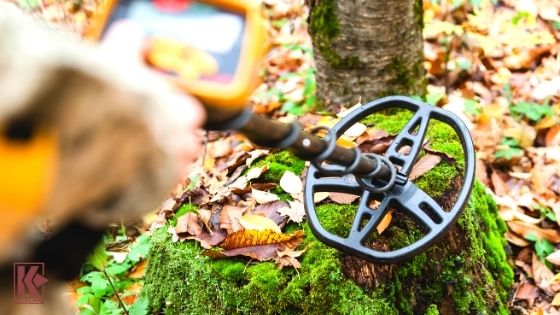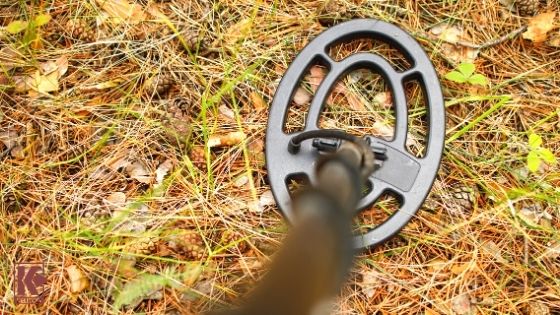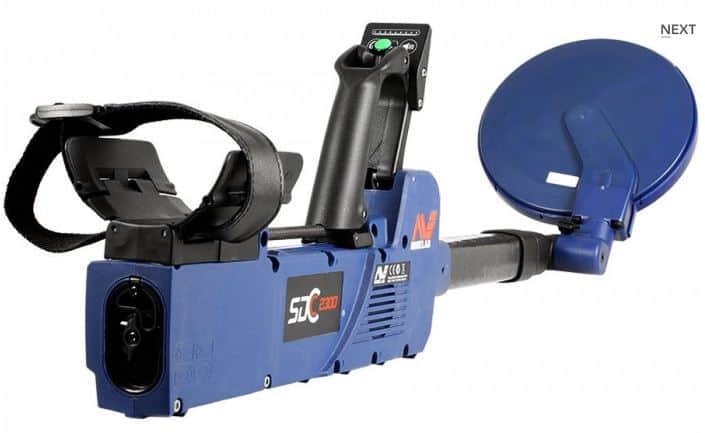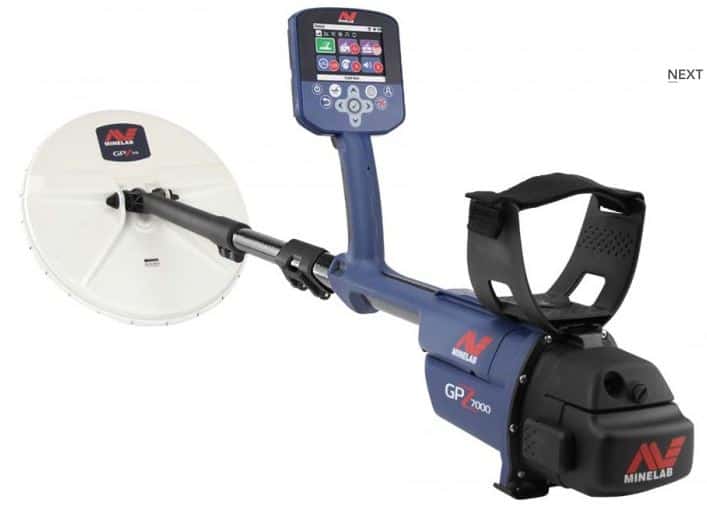Gold Prospecting: The Complete Guide
Published by John Matuszak on 07/19/20
There are many misconceptions and uncertainties when it comes to gold prospecting. Gold expert and Executive Director of Development for GPAA, Kevin Hoagland, sat down with us briefly to give us a deep dive into the world of gold prospecting. The following tips are based on his knowledge and experience, and of course his success with finding gold.
Gold Prospecting Equipment: VLF Metal Detector vs. PI Metal Detector
VLF (Very Low Frequency) Metal Detector
A VLF metal detector is a single or multi-frequency machine

Metal Detecting In The Woods
that consists of a continuous sine wave. The sine wave(s) goes down and into the ground to find a metallic target, and once it does, the machine charges the target releases an eddy current and sends a signal back.
A common misconception for these machines is that you cannot get depth out of a VLF metal detector. That is not true, as long as a VLF machine is properly set up and you are using the right detector in the right conditions with the right coil, you can absolutely get depth with this machine. Yes, a VLF detector can have an advantage on shallow very very small targets, on and off of bedrock. As long as you can keep it stabilized, ground balanced, and the sensitivity is set properly, this can help you find some of the smallest gold pieces, many in the grain over gram range.
PI (Pulse Induction) Metal Detector
I guess that my best and easiest description of PI metal detectors is a machine that talks and then listens. Unlike the VLF detector, a PI machine is not a continuous sine wave it is a pulse, on-off, on-off. These machines will do better than VLF in most highly mineralized soils because it’s measuring
the speed of the signal decay of the target and the ground around the target. However, there are places like low mineralization deposit areas where your PI machine will simply just not work to its fullest potential and in these places, you are better off with a VLF machine, and vice versa. For example, if you have excessive cold or hot rocks and or weird salts, there have been times when a VLF detector has been outperformed by a PI machine.
How Does Frequency Work in a VLF Metal Detector?
The higher the frequency, the closer to the surface the machine works to find smaller targets. The lower the frequency, the deeper in the ground the machine will go to find larger and more conductive targets. It’s not the case that one machine or frequency works better than another, it depends on the conditions and the ground that you’re detecting, coil size, and your tuning. Frankly, for me when I head out detecting, I have a VLF and PI with me and I do recommend that you carry both types of machines, if you can, to be prepared for all of the varied conditions and the ground to change and to get the best results.
What is a Hot Rock?

Hot Rocks in the Desert
One of the most common questions received in the metal detecting industry is, what is a Hot Rock? Hot rocks are magnetic or have metallic properties that are higher than the surrounding ground. No matter what, it is seen as a target to your machine which can be disrupting if you don’t know how to properly mitigate them. Keep in mind, hot rocks will never be 100% avoided, but there are ways to reduce the number of hot rocks you come in contact with.
Different Types of Mineralization
There are two types of mineralization considered the most associated with nugget hunting. First, there is high mineralization within the ground, where the ground itself is hot and can contain hot rocks or cold stones. The second type of mineralization is moderate or benign, where there is less mineralization in the ground. Many people confuse hot mineralization for hot rocks, but these are two different things. Moderate or benign mineralization can also contain hot rocks, and it’s actually this combination that can cause the mitigation of this to be very challenging.
Another misconception is assuming orange soil is always hot. It’s very possible that if you see orange soil, it’s most likely hot. However, it could just be a red iron pigment. It’s important not to immediately jump to that conclusion.
What are the Different Types of Coils?
Three Different Types of Coils
- Mono Coils: A mono coil is designed for a PI machine and is a single winding which puts a concentric pattern into the ground. You will always be able to get more depth with a mono coil, but it is also more susceptible to ground mineralization noise and it will be affected by the ground mineralization itself. Using a mono coil, you have to be very aware of what your overlap is. The second part of the Mono coil question is when to take the Mono off and go to a Double D coil. That answer is simple, when you can no longer detect with a Mono is when you go to a Double D.
- Double D Coils: Double D coils work for both PI and VLF machines. Double D coils have two back to back D-shaped windings inside the coil. At all times the coils are transmitting, and another receiving across the plane of the coil. The Double D coil design is like a knife blade that goes into the ground down the center of the coil. These coils are great at handling mineralization where it essentially takes the ground mineralization and distributes it all the way across the blade lessening its effects.
- Concentric Coils: The third type of coil is the concentric coil. Many people think concentric coils are the same as mono coils however, that is not the case. Mono coils are built for a pulse induction machine using one winding whereas concentric coils work with VLF machines by using two separate windings one sends one to receive. Although they are similar in design, they work in two completely different ways for two completely different detectors.
Round vs. Elliptical Coils

Elliptical Coil Detecting
Metal detector coils are measured off of a round coil configuration. That being said, there is really no difference in size, only in shape. For example, a 14×10 coil will have the same attributes as a 12-inch coil. Why are there two different kinds then? The key difference here is that elliptical coils work extremely well in difficult areas such as in between scrub bushes and rocks. If you are still trying to wrap your head around that, here is a simple way to make sure you choose a coil size that is different from what you already have:
Length + width = X ÷ by 2 = the size of the coil. Take a 14×10 coil for example, 14+10=24 ÷ 2 = 12. You have a 12-inch coil.
Discrimination in Gold Prospecting Machines
There is no truly accurate nonferrous discrimination on gold detectors and discrimination for gold is dangerous. Iron discrimination is really the only type of discrimination on a gold machine and at best, this discrimination works “kinda.” Trusting these signals is dangerous and can lead to missed gold, so do your best to operate your machine to the best of its ability without assuming anything. Even with the best iron discrimination, you should dig these targets until you know for sure they are ferrous junk, understanding that if there is any wavering in the signal of another target that sounds “almost the same,” it has to be dug.
East vs. West: Where Can You Dig for Gold in the United States?
Many people assume that the West is a better place to go gold prospecting due to its history of gold mining, but this isn’t completely true. No matter where you go, make sure searching for recreational gold is legal. This is especially true in places like national forests.
The key differences between the two locations are the gold mineralization area, with the West containing a lot more open ground and hotter ground. That being said, there is a gold belt that runs from the northeastern United States and through Alabama. Not to mention there is a lot more glacial gold in the eastern US. Although geography is going to be different, gold is gold, and the best place to look for gold is where it has been found before – even if that doesn’t mean states with a history of gold fever.
The biggest issue with both the West and East is going to be finding accessibility and being able to find that line and stay on that line. However, western states like Arizona and even Alaska were developed to be able to go gold prospecting, gold mining, and staking claims during the gold rush, which is why these states are known to have easier access.
What Do You Need to Prospect for Gold?
The Best Gold Prospecting Metal Detectors
Though you may not need literal gold mining equipment, it never hurts to have your own prospecting equipment, especially if you don’t have a gold pan. There really is no “best” metal detector and there’s not a detector that fits all. Each metal detector has different pros and cons and it’s all about using your machine to the best of its ability to find your desired gold deposits. Because of this, every gold prospector has their own preferred machine. As mentioned previously, it helps to have a VLF machine and a PI machine because you just don’t know what the conditions or ground will be like. It also helps to have a variety of machines, if possible.
Although there are no “best” metal detectors, here are a few that you can choose from:
Fisher Gold Bug Pro
The Fisher Gold Bug Pro features high sensitivity to small gold nuggets, but this detector also works well as an all-purpose metal detector. The coil is 5 inches, making it perfect for small gold, but you can also fit it with an 11 inch DD search coil.
Price: $549
Weight: 2.5 lbs.
Frequency: 19 kHz
Waterproof: No
Warranty: Five-year

- Can change modes to detect other objects
- Lightweight so you can hunt for hours
- Small coil is perfect for small gold
- Can be hard to decipher tones
- No arm strap included
- May need to purchase additional coil for other targets
- I live in Alaska and the first time out, it located a small nugget. Easy to use and very sensitive. It's also very light and won't wear your arm out like other detectors. - Colin
Minelab GPX 4500
This detector features SETA technology and is immune to interference. SETA stands for “Smart Electronic Timing Alignment.” Noises that are caused by magnetic interference are minimized in each of the six timing options, and each timing option can be independently adjusted and operated for greater efficiency.
This detector has many special features. It has a backlight on the screen so you can detect at night or in dark areas. The stabilizer provides you with a smoother threshold to pick up the faintest of signals, and the “iron reject” option lets you filter out junk metal.
- Weight: 5.3 pounds
- Frequency: Bi-Level, Advanced Pulse Induction
- Waterproof: No
- Warranty: Three-year limited

- Workhorse: Best general-purpose gold & relic machine
- Excels in highly mineralized ground (pulse induction)
- Full range of coils for finds buried deep
- Heavy weight
- It is not waterproof
- Battery life tends to decline over time
Minelab SDC 2300
The Minelab SDC 2300 gold metal detector is built to perform in the toughest conditions. Features easy-to-use controls and no assembly is required. Includes headphones and an 8″ round mono search coil.
Weight: 5.3 lbs
Frequency: Pulse Induction
Waterproof: Yes, fully submersible up to 10 feet of water
Warranty: Three year limited

- Picks up on gold left behind by previous models
- Compact
- Waterproof
- No junk discrimination
- The more I use this detector the happier I am with it and its finding good gold for me. I took my brother in law out with me and with the external speaker gave him a few lessons in nugget detecting. There were a bunch of old 22 caliper brass shells at this one place, and I told him we needed to get these out of the way because they would shield us from hearing any smaller targets. Sure enough, we got them out of the way, and right in the middle of where they were was a fainter target. I told him that while larger nuggets would sound like those brass shells near the surface, most gold would sound like this fainter target. We found three small nuggets. - Anonymous
Minelab GPZ 7000
With the Minelab GPZ 7000, you’ll find even the smallest gold nuggets you might miss with other detectors. The Super-D Smart Coil consists of a central transmit winding and two outer receive windings, which greatly decreases interference from magnetic and/or mineralized soils. This detector finds nuggets that are up to 40 percent deeper than previous Minelab GPX models.
This is the most expensive metal detector in our guide, but we think that the payoff is worth it for this Zero Voltage Transmission machine.
- Weight: 7.32 pounds
- Frequency: ZVT (Zero Voltage Transmission)
- Waterproof: Standard coil is waterproof to 1m/3ft.
- Warranty: Three-year limited

- Deepest detection depth on all types gold
- Electronically updateable via Minelab’s website
- Full range of gold timing for all situations
- Very heavy
- Not waterproof
- No arm rest strap
Minelab Gold Monster 1000
Minelab’s Gold Monster 1000 has a gold chance indicator, so you can know the likelihood of whether there is gold before you start digging.
The controls are easy to use, the coil is waterproof up to 3-feet, and the control box is rain proof. It also comes with your choice of coils, battery options, and shaft configurations.
The intermediate 45 kHz frequency and high-speed signal processor boosts sensitivity to gold, no matter the size of the nugget.
- Weight: 2.94 pounds
- Frequency: 45 kHz
- Waterproof: No. Coils are waterproof.
- Warranty: Two years for control box and coil

- Affordable
- Great at picking up fine gold
- Light weight
- Not waterproof
- Does not handle mineralization well
- Not as deep as pulse induction machines
Nokta Makro AU Gold Finder
The Gold Finder is designed to find gold nuggets in any terrain, at multiple depths.
Users can set the detector to “fast” mode for gold hunting in fields with high mineralization or significant quantities of conductive rocks. This mode improves target detection and recovery speeds in areas where there is a lot of trash.
“Deep” mode gives the user a two-tone discrimination setting designed for goldfields with less mineralization or magnetic rocks. It provides an increase in depth performance while still able to pinpoint large and small gold nuggets.
- Weight: 3.1 pounds
- Frequency: 56 kHz
- Waterproof: Search coils are waterproof
- Warranty: 2-year limited

- Super hot on tiny gold nuggets!
- Best of class mineralization handling for VLF.
- Iron discrimination & deep all metal mode for maximum depth.
- Ground balance always in tracking, no fixed setting.
- No target ID numbers, only iron reject and “gold chance” meter.
- Dedicated gold detector, not multi-purpose.
- Nokta did it right, they listened to the detectorist and built into one detector what we have been looking for. High frequency response with the ability for hitting small (sub-gram) gold nuggets, auto and manual ground balance, precise sensitivity adjustment capabilities, reliable and clear threshold and the sheer ability to handle iron ground minerals were the requirement. The fact that the Gold Finder is lightweight, hip-mountable, has long battery life and a decent price tag, well that’s just more gold in the poke. - Kevin H.
Whites TDI SL
White’s TDI SL metal detector meets the demands of gold prospectors looking for both extremely small and extremely deep nuggets. It’s simple to operate. Includes 12″ dual field search coil, one Lithium Ion rechargeable battery pack and a two-year warranty. A 7.5 ” dual scan coil is also available.
Weight: 3.5 lbs.
Frequency: PI
Waterproof: No
Warranty: Two-year

- Very stable in salt water
- Simple rejection switch for metal conductivity
- Lightweight
- Low discrimination ability
- Not waterproof
- I bought my TDI in September of 2014. I use this machine to hunt wet sand on beaches for coins and jewelry and it is awesome for deep finds and mineralized wet sand. WARNING!!! It finds everything made of metal!! It's not uncommon to fine a bobby pin at 18 inches. But... that could have been a gold ring too! I use the "HIGH" setting in parks to look for coins and it finds silver very well. Many quarters and dimes and some medium sized rings but not many pennies at that setting and very little iron or pull tabs. It is a high producer in heavily trashed ground. Where it really shines is when I prospect for gold nuggets. I've found several here in Oregon and it has no problem in tailings and mineralized ground. It's light weight and extreme sensitivity make this a real go-getter of a metal detector. - Dennis P
Garrett ATX Pro for Gold
The Garrett ATX is a ground-balancing PI system that emits 730 pulses per second using a non-adjustable multi-frequency technology that operates between 0-73khz. The detector uses multiple internal coils working together simultaneously as both transmitter and receiver. Each of the 730 millisecond-long pulses create a magnetic field within the object being detected, which then immediately collapses and sends a response pulse back to the coil.
Weight: 6.9 lbs.
Frequency: Emits a maximum frequency of 730 pulses per second
Waterproof: Submersible in up to 10 feet of water
Warranty: Two-year warranty

- The ATX has notch discrimination capability
- Features both a manual and automatic ground balance/tracking capability
- The extremely rapid pulse lengths allow the ATX to penetrate highly mineralized ground that traditional VLF can not
- Rapid pulse lengths can't be easily separated and measured
- -
Beginner’s List of Prospecting Tools
- The very best headphones you can afford. And wear them all the time. Many of the gold nuggets you will find are only slight whispers in the detector’s threshold. Many nice nuggets have been left in the ground because the prospector was not wearing metal detector headphones.
- Two plastic scoops at all times. The more technologically advanced the detectors are becoming, the more sensitive they are becoming. Gold machines tend to pick up mineralization on your hands and to avoid this you can use two plastic scoops to go back and forth between the dirt or sediment and your targets. Also, always use a plastic scoop and not your hands especially when detecting in a desert to avoid being bitten by scorpions or other living things.
- A digging tool. Do not show up with a geologist pick. You need a digging tool and you need something that has a wide blade. For example, Apex Picks are a great option. When you start digging targets, you have to be able to get your coil out of the hole, so having a sharp pointed tool to dig and a wide blade to clear is the best tool to get this job done.
- Non-magnetic boots. Also known as Anti-Terrorism Military boots. As mentioned above, the more advanced these machines are becoming, the more they will pick up. Make things easier on yourself and get a pair of boots with no metal to avoid your machine picking up any false signals.
- A non-magnetic belt. Like the boots, if you need to wear a belt, choose one without any metal. Overall, limit the amount of metal on your body.
- Put your car keys in your back pocket.
- Keep your cell phone off and in your back pocket.
- A good hat.
- Awater bottle or hydration pack is a must.
For more tips on the best metal detector for gold, be sure to check out our complete buyer’s guide.
What Should You Look For When Gold Prospecting With and Without a Metal Detector?

Antique Compass, Prospecting Map and Gold
With gold panning, 99.9% of the time, wherever there is gold there is black sand. However, this cannot be reversed, if you find black sand that doesn’t mean there is definitely gold in the same area (although it is possible). The most important thing you can do before gold prospecting is to understand your surroundings and the area you will be hunting.
- Think like gold! “If I were 19 times heavier than the same volume of water, where would I go?”
- Understand the streams and the water dynamics or the deserts around you.
- Take a look at the overall geology. Look closely at what is easy to see and deeper, to see what others miss.
- Take notice of any big trees or massive boulders that will change water flow.
- Don’t forget about the inside bend, but also keep in mind there are so many things that can change the way gold drops out of the flow.
- Do your research beforehand.
Final Word
Words from Kevin Hoagland, the expert prospector himself, “be willing to do your research.” The best place to look for gold is where gold has already been found – even gold rush states like Arizona, Alaska, and Oregon can be literal gold mines!
Gold is one of the most elusive metals out there and is not simple to find. If it were, it wouldn’t be so valuable. The best thing you can do if you’re interested in gold prospecting is to make a commitment to yourself that you are going to go prospect and that you will do your research on where you are going. Put a plan together and execute the plan.
Finally, you are going to need to learn how to slow down more than you ever have before. Your gold prospecting success depends on your commitment and patience to the process.
